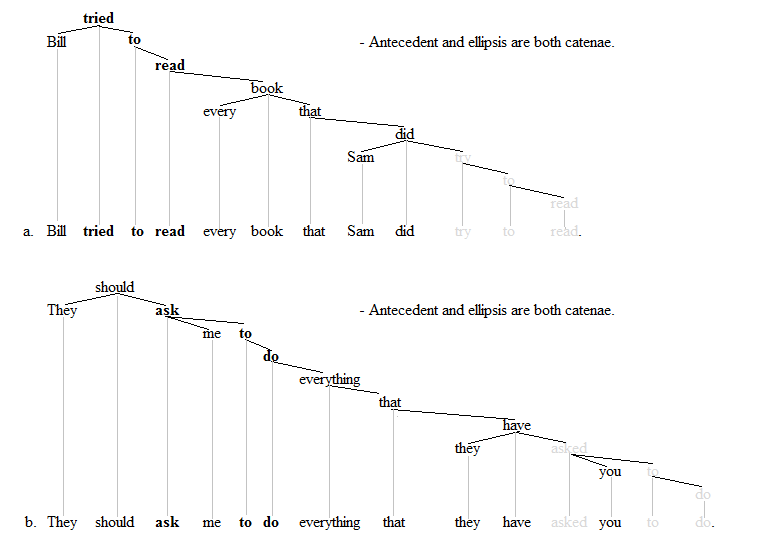Antecedent-contained deletion
Antecedent-contained deletion (ACD), also called antecedent-contained ellipsis, is a phenomenon found in contexts containing verb phrase ellipsis and a quantifier. The ellipsis appears to be contained inside its antecedent, which should result in an infinite regress and thus ungrammaticality. The problem arises in phrase structure grammars that take the constituent to be the fundamental unit of syntactic analysis.[1] It does not arise if the catena is taken to be the fundamental unit.[2] The catena is associated with dependency grammars (DGs).[3]
The problem in phrase structure grammars
To understand the issue involved, it is necessary to understand how VP-ellipsis works. Consider the following examples, where the expected, but elided, VP is represented with a smaller font and subscripts and the antecedent to the ellipsis is in bold:
- John washed the dishes, and Mary did wash the dishes, too.
- John washed the dishes on Tuesday, and Mary did wash the dishes on Tuesday, too.
In both of these sentences, the VP has been elided in the second half of the sentence. In both cases, the elided VP should be essentially identical to the antecedent in the first clause. That is, the missing VP in the first sentence can only mean wash the dishes, and in the second sentence, the missing VP can only mean wash the dishes on Tuesday. Assuming that the missing VP must be essentially identical to an antecedent VP leads to a problem, first noticed by Bouton (1970):
- John read every book that Mary did read every book that Mary did read every book that Mary did read every book etc..
Since the elided VP must be essentially identical to its antecedent and assuming that the antecedent is a full VP, an infinite regress occurs, as indicated by the subscripted material, which would continue to repeat itself ad infinitum. That is, if we substitute in the antecedent VP into the position of the ellipsis, we must repeat the substitution process ad infinitum. The difficulty is illustrated further with the tree for the sentence:
The light grey font indicates the elided constituent, i.e. the ellipsis, and the underline marks the antecedent constituent to the ellipsis. Since the antecedent constituent contains the ellipsis itself, resolution of the ellipsis necessitates an infinite regress as the antecedent is substituted ad infinitum into the ellipsis cite. To avoid this problem, Sag (1976) proposed that the NP every book that Mary did undergoes quantifier raising (QR) to a position above the verb.[4]
- [every book that Mary did...]i John read ti.
Now the reference for the elided VP is simply the following:
- read ti
The analysis can now assume that the elided VP in the example corresponds to just read, since after QR, the antecedent VP no longer contains the object raised NP. The result is the following analysis:
- [every book that Mary did read] John read.
The infinite regress is now avoided because after QR, the antecedent VP contains just the verb read.
The catena analysis
An analysis of VP-ellipsis that takes the catena to be the fundamental unit of syntactic analysis (as opposed to the constituent) is not confronted with the antecedent containment problem. The ellipsis can correspond to a non-constituent catena, which means a movement analysis in terms of QR is not needed.[5] The catena is a concrete unit of syntactic analysis associated with dependency grammar (DG); it is defined as any word or any word combination that is continuous with respect to dominance. The subscripted material in the examples above all qualify as catenae. The point is illustrated with the following further examples:
Both the elided material (in light grey) and the antecedent (in bold) to the elided material qualify as catenae. As catenae, both are concrete units of syntactic analysis. The need for a movement-type analysis (in terms of QR or otherwise) does not occur. One can note that the second of the two examples is an instance of pseudogapping, pseudogapping being a particular manifestation of VP-ellipsis.
See also
Notes
- ↑ See for instance Bouton (1970), Sag (1976), May (1985), Baltin (1987), Hornstein (1994), and Kennedy (1997).
- ↑ Concerning the catena unit in general, see Osborne et al. (2013).
- ↑ See for example Ágel et al. (2003/6).
- ↑ Culicover (1997:283ff.) provides an overview and critique of the QR analysis of the ACD-phenomenon. Carnie (2013) compares the QR analysis to an alternative movement analysis.
- ↑ The extent to which the elided words of VP-ellipsis correspond to catenae is discussed and illustrated in Osborne and Groß (2012).
References
- Ágel, V., L. Eichinger, H.-W. Eroms, P. Hellwig, H. Heringer, and H. Lobin (eds.) 2003/6. Dependency and valency: An international handbook of contemporary research. Berlin: Walter de Gruyter.
- Baltin, M. 1987. Do antecedent-contained deletions exist? Linguistic Inquiry 18, 4, 579-595.
- Bouton, L. 1970. Antecedent-contained pro-forms. In Proceedings of Sixth Regional Meeting of the Chicago Linguistic Society, ed. M. Campbell Chicago, IL: University of Chicago.
- Carnie, A. 20013. Syntax: A generative introduction. 3rd edition. Malden, MA: Wiley-Blackwell.
- Culicover, P. 1997. Antecedent-contained deletion. Oxford, UK: Oxford University Press.
- Hornstein, N. 1994. An argument for Minimalism: The case of antecedent-contained deletion. Linguistic Inquiry 25, 3, 455-480.
- Kennedy, C.. 1997. Antecedent-Contained Deletion and the Syntax of Quantification. Linguistic Inquiry 28, 4, 662-688.
- May, R. 1985. Logical Form: Its structure and derivation. Cambridge, MA: MIT Press.
- Osborne, T. and T. Groß 2012. Antecedent containment: A dependency grammar solution in terms of catenae. Studia Linguistica 66, 2, 94-127.
- Osborne, T., M. Putnam, and T. Groß 2012. Catenae: Introducing a novel unit of syntactic analysis. Syntax 15, 4, 354-396.
- Sag, I. 1976. Deletion and Logical Form. MIT dissertation.

